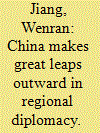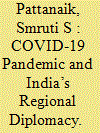| Srl | Item |
| 1 |
ID:
134622


|
|
|
|
|
| Summary/Abstract |
Initially, recognition of the vital role played by regional diplomacy did not accompany NATO’s substantial commitment to economic and political development in Afghanistan from 2001 to 2014. Pakistan in particular had a major influence on the conduct of reconstruction efforts and NATO’s efforts to lay the institutional foundations in Afghanistan. Canada, an early and committed participant in the International Security Assistance Force, would by 2005 come to recognise the vital importance of the role of Pakistan in the outcome of the mission. However, regional limits to the influence of the United States, the North Atlantic Treaty Organisation, and Canada made comprehensive efforts unattainable.
|
|
|
|
|
|
|
|
|
|
|
|
|
|
|
|
| 2 |
ID:
074342


|
|
|
| 3 |
ID:
177776


|
|
|
|
|
| Summary/Abstract |
The COVID-19 pandemic placed enormous stress on the fledgling health infrastructure in the South Asian region. The economic distress compounded the problem as many business houses closed down and people working in the informal sector lost their jobs. The governments in the region, except in Pakistan, went for a complete lockdown to contain the spread of the pandemic. India which prides itself as the ‘Pharmacy of the world’ geared up to provide humanitarian assistance by supplying essential medicines, ventilators and providing rapid-action teams consisting of medical professionals to assist its neighbours as a first responder. It also supplied vaccines to the immediate neighbourhood once they were ready. India’s health diplomacy enhanced its soft-power projection and helped it project itself as a country that is concerned about its neighbours—a major shift in its regional diplomacy, compared to the Cold War period. This article maps India’s regional diplomacy in the historical context and analyses the making of India’s regional diplomacy in the context of COVID-19 pandemic.
|
|
|
|
|
|
|
|
|
|
|
|
|
|
|
|
| 4 |
ID:
126910


|
|
|
| 5 |
ID:
140608


|
|
|
|
|
| Summary/Abstract |
The SAARC was designed to improve both the economic and social progress of its member states. But, unfortunately ever since its formation there have been hindrances to the regional cooperation. Differences in political system among the member countries make regional cooperation difficult. Asean countries must decide whether to retreat into protectionism or reaffirm their commitment to a more open approach. It does not have the kind of deep institutional ties and infrastructure links that bind together the European Union’s members. If integration strategy is fully implemented and capturing a larger share of global manufacturing, the Asean countries could gain $280-625 billion in annual gross domestic product (GDP) by 2030.
|
|
|
|
|
|
|
|
|
|
|
|
|
|
|
|
| 6 |
ID:
140633


|
|
|
|
|
| Summary/Abstract |
Over the past few years, the global economy’s centre of gravity has been moving away from the advanced countries, as the emerging economies have become the new growth poles. The focus on the emerging economies has increased considerably since the BRIC countries not only convened the first meeting of their leaders in 2009, but also added South Africa in less than three years. The paper examined the nature of co-ordination among the BRICS countries, and whether the presence of South Africa has made a difference to the group’s dynamics. There are areas in which the emerging economies have co-ordinated their positions and have thereby been able to put up a joint front. This has been most visible in the WTO negotiations on intellectual property rights and agriculture, the two areas in which the developed countries have dominant positions. But while in the WTO, the emerging
economies were proactive in making joint interventions in the climate change negotiations to further their aspirations. It is the ability of the BRICS to set the global economic agenda in forums like the G-20 that would mark the coming of age for the grouping. Thus far, they have not made any substantive alterations in the dynamics at the ‘high table’. A more co-ordinated approach on issues that unify them would better enable and strengthen them, and would help to justify their presence on the ‘high table’.
|
|
|
|
|
|
|
|
|
|
|
|
|
|
|
|
| 7 |
ID:
146471


|
|
|
| 8 |
ID:
111707


|
|
|